The new exhibit, 30 Americans. One Nation. Thirty Experiences, at the Detroit Institute of Arts, runs until January 18, 2016. I highly recommend planning a trip to Detroit to see this.
Why? This exhibit is a powerful look at race, power, art, and culture...and there's more to it than you can imagine.


Triple Portrait of Charles I, Kehinde Wiley.
"A police mug shot of a young black man inspired artist Kehinde Wiley to create a series of paintings. As a type of portrait, mug shots deny their subjects the choice of where and how to pose. In contrast, Wiley collaborates with his models, who select portraits from art history books that reflect an important aspect of their character. He depicts black men and women in the way they want to be seen." Top photo adapted by Wandering Educators.


Soundsuit. Nick Cave, 2008, fabric, fiberglass and metal.
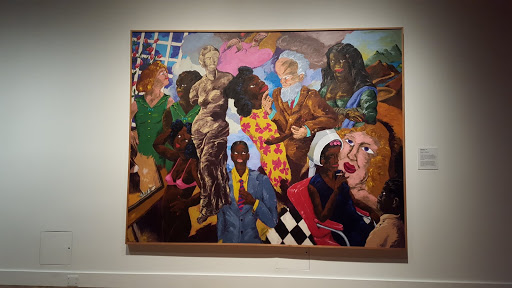
Pygmalion. Robert Colescott, 1987, acrylic on canvas.
30 Americans: One Nation. Thirty Experiences. includes 55 paintings, sculptures, installations, photographs and videos by many of the most important African American artists who rose to prominence during recent decades by exploring racial, gender, political and historical identity in contemporary culture.

Foreground:
Untitled #25, Leonardo Drew, 1992, cotton and wax
By stacking more than sixty blocks of roughly the same size and shape, sculptor Leonardo Drew creates a minimalist, grid-like pattern. But his choice of material—cotton, the main product of the American South during slavery—opens up other interpretations.
Background:
The New Negro Escapist Social and Athletic Club (Thurgood), Rashid Johnson, 2008, Lambda print
Swirls of smoke surround a contemporary young man with a serious expression. His hairstyle and formal attire are intended to remind us of Frederick Douglass, who escaped slavery and became an influential abolitionist. Artist Rashid Johnson said, “I love this idea of the black character being a person who could potentially be rejuvenated and become something new….It’s like, ‘Oh, there’s a new black? How exciting—I want to meet that.’”
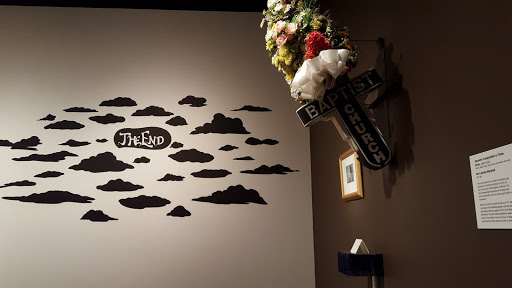
The one on the left that says “The End” is just one part of a work by Kara Walker, entitled Camptown Ladies, 1998, paper and adhesive on wall. In this pre-Civil War scene, artist Kara Walker explores an upbeat 1850 minstrel song in its historical context. Known for infusing fact with nightmarish fictions, Walker explores ideas of race and the ongoing psychological trauma of slavery.
Walker works in the silhouette technique, a method of making inexpensive portraits from cut black paper that was popular in the 1700s and 1800s. Although cut with precision and detail, the paper forms omit information and reduce the complexity of the figure—like a stereotype. Walker uses the silhouette to force viewers to examine their own perceptions. Ask yourself how—and why—you interpret a figure to be black or white. A man rides a woman like a horse using a whip and dangling a carrot. The image plays off the idea of motivating behavior by force or reward. A carrot appears in two other scenes along these walls. Curving lines hint at race tracks referenced in the lyrics of the Stephen Foster song Camptown Races, written for minstrel shows in which white actors performed racist caricatures in black face. A child aims a slingshot at a woman. She, in turn, holds up an infant that urinates into the mouth of another woman. A woman with a carrot in her buttocks races toward piles of excrement labeled “end.”
Foreground: Souvenir: Composition in Three Parts, Kerry James Marshall, 1998–2000, plastic, glass, paper, wood, steel, and framed video still
This work explores the racially motivated 1963 bombing of an African American church by the Ku Klux Klan in Birmingham, Alabama. The floral arrangement replicates an original one from a memorial to the four young girls killed in the attack. Notice the card that reads “As seen on TV.” Media coverage of the bombing played a pivotal role in generating national support for the Civil Rights Movement. The work raises questions about the power of the media—then and now—to shape public opinion around issues of race in America.
Among the renowned artists included are Barkley Hendricks, Kerry James Marshall, Carrie Mae Weems, Lorna Simpson and the late Jean-Michel Basquiat and Robert Colescott. Their influence on a younger generation can be seen in the works of artists such as (my favorite) Kehinde Wiley, Nick Cave, Mickalene Thomas, and Kara Walker.
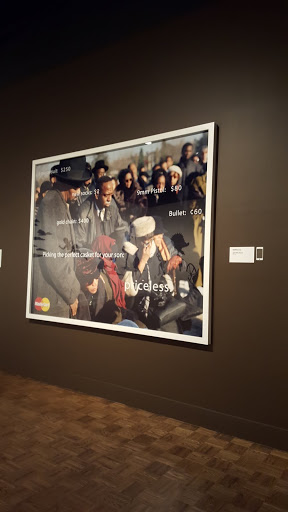
Priceless, Hank Willis Thomas, 2004, digital chromogenic print.

Duck, Duck, Noose, Gary Simmons, 1992, wood, cloth, metal, and hemp

Man’s Country I, John Bankston, 2004, oil on linen
The exhibition is drawn from the acclaimed Rubell Family Collection, Miami. In describing the origins and development of the exhibition, Don and Mera Rubell state: “As the show evolved, we decided to call it 30 Americans. ‘Americans,’ rather than ‘African Americans’ or ‘Black Americans,’ because nationality is a statement of fact, while racial identity is a question each artist answers in his or her own way, or not at all. And the number 30 because we acknowledge…that this show does not include everyone who could be in it.”

Hotter than July, Mickalene Thomas. an 1883 painting by Manet. This contemporary African American woman, surrounded by bold colors and patterns, looks confidently out at the viewer. She takes center stage and asserts her sexuality and control over her own body. As a femal artist, Mickalene Thomas challenges nineteenth-century European images of women painted by white men for male enjoyment. Inspiration: an 1883 painting by Manet.

Equestrian Portrait of the Count Duke Olivares. Kehinde Wiley, 2005, oil on canvas
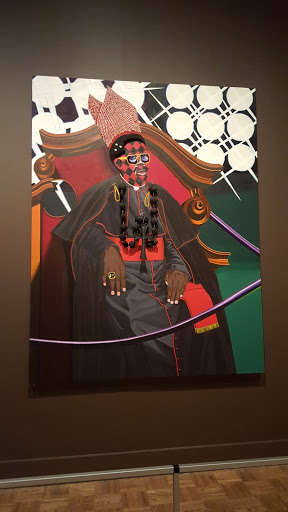
Exhibit A: Cardinal Francis Arinze. Jeff Sonhouse, 2005, oil and mixed media on wooden panel
““30 Americans” powerfully demonstrates contemporary African American artists’ interests in the complexities of identity and developing a range of artistic approaches to portray or reference its distinctions and similarities,” said Valerie J. Mercer, DIA curator and department head, General Motors Center for African American Art. “This is the first time the work of most of these artists will be on view at the DIA, as well as in Detroit. We’re honored to have the opportunity to share the creative brilliance of the contemporary African American artists whose art is included in the prestigious Rubell Family Collection.”

Gold Nobody Knew Me #1. Glenn Ligon, 2007, acrylic and oil stick on canvas.
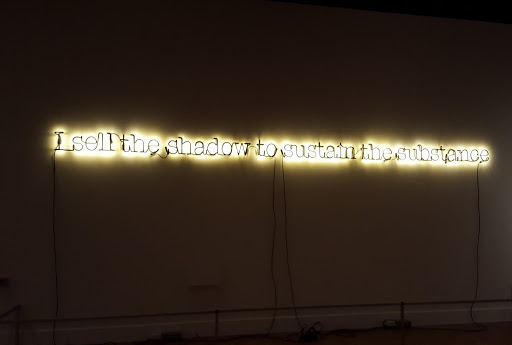
Untitled (I Sell the Shadow to Sustain the Substance). Glenn Ligon, 2005, neon sign and paint, Ed. 3/3.

Sleep. Kehinde Wiley, 2008, oil on canvas.
The exhibition is organized around several artistic approaches used to explore identity: defying Western art traditions; portraying black subjects as real people as opposed to types; sampling multiple sources of inspiration; adopting improvisational and expressionistic styles to demonstrate creative and technical virtuosity; the use of symbols, materials and images that imply or trigger associations about gender, race, religion, class and sexuality; transforming the body’s appearance to examine the relationship between societal assumptions and identity; and confronting American history regarding race, racism and power in the United States.

Bird On Money. Jean-Michel Basquiat, 1981, acrylic and oil on canvas.
![Untitled (after Kikugawa Eizan's "Furyu nana komachi" [The Modern Seven Komashi]). Iona Rozeal Brown, 2007, acrylic and paper on wooden panel. From Love, Change, and the Expression of Thought: 30 Americans at the Detroit Institute of Arts](https://lh3.googleusercontent.com/-l_q3XgpdfjY/VktnL5N5H1I/AAAAAAAAnXQ/TBJOFF1_ZZQ/s512-Ic42/20151114_150207.jpg)
Untitled (after Kikugawa Eizan's "Furyu nana komachi" [The Modern Seven Komashi]). Iona Rozeal Brown, 2007, acrylic and paper on wooden panel.
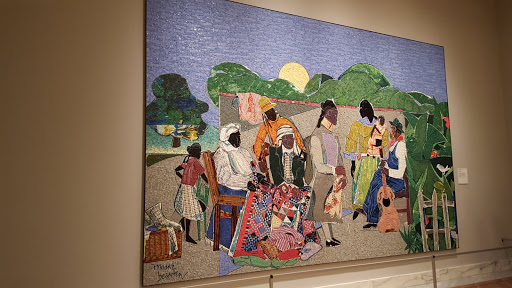
Quilting Time. Romare Bearden, 1986, Mosaic tesserae mounted on plywood.
Moving through the exhibit, I saw people standing close and far away, listening, reading, taking it in, smiling, being serious, talking quietly, taking photos. What you never know, in real life, is how people feel about certain things. But one of my favorite parts of this exhibit was the comment cards after the exhibit.
Here, you have a glimpse into the power, emotions, and effects of this exhibit.
Take a look at a few of the hundreds of comment cards - you'll be impressed.
Art matters - to everyone.

Love, Change, and the Expression of thought

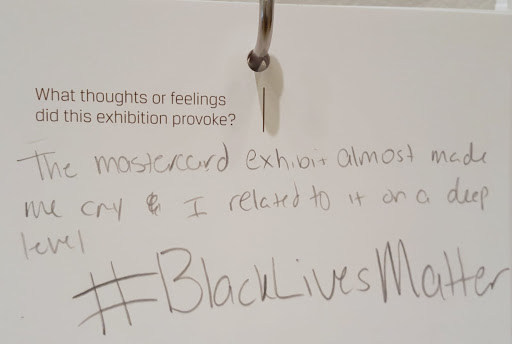
The Mastercard exhibit almost made me cry. I related to it on a deep level. #BlackLivesMatter
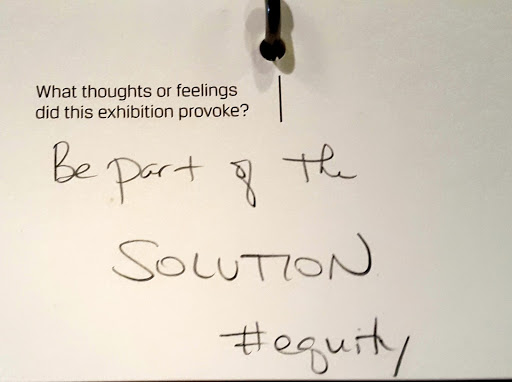
Be part of the solution. #equity

Made me think about my childhood. I saw my Grandma. I saw Black men exalted above the norm. I saw pain! That bundle of clothes disturbed me. That funky rug or carpet reminded me of being poor and having to accept other peoples funk! The experience was invigorating and provocative - I loved it! Great job!
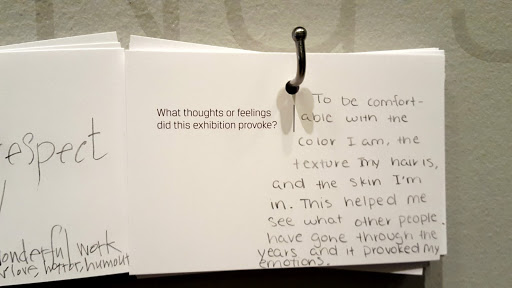
To be comfortable within the color I am, the texture my hair is, and the skin I'm in. This helped me see what other people have gone through the years and it provoked my emotions.

I felt as though it brought light to matters that aren't talked about often. It made me feel as though it was a walk in everyday life of most black people. I loved it. Thank you for having this exhibit.

Tolerance. Rick Ross- "Red on the wall, Basquiat when I paint."
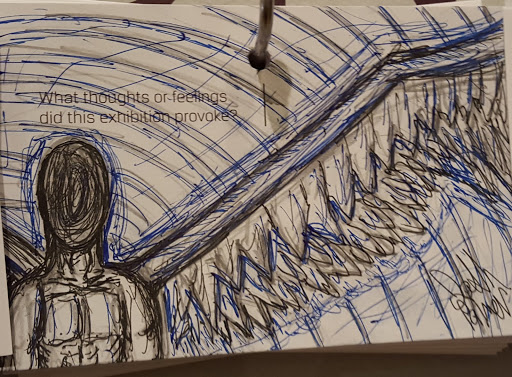

Comfortable in my own skin.
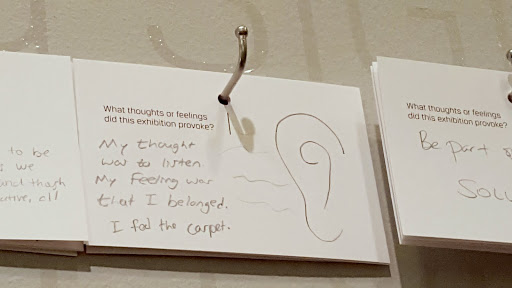
My thought was to listen. My feeling was that I belonged. I fed the carpet.

I really enjoyed the exhibit and felt that this exhibit provided and stimulated a lot of African American history through different creative processes of each artist. The Duck, Duck, Noose exhibt was definitely a little overwhelming to me and I could see why that exhibit would be a "fire starter" - overall, great exhibit.

History is not only what we are taught.

This exhibition provoked creativity, diversity, and modern day struggles! Eye opener!

Seeing art through the ages made out of different materials makes one think about what the definition of art is.
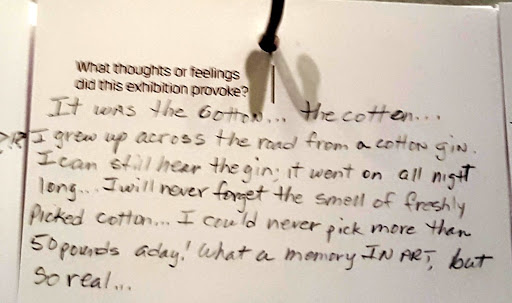
It was the cotton...the cotton... I grew up across the road from a cotton gin. I can still hear the gin; it went on all night long... I will never forget the smell of freshly picked cotton... I could never pick more than 50 pounds a day! What a memory IN ART, but so real...

An identity that is held - firmly - by the perceptions of others, and most exclusively the perceptions of others, is an identity nonetheless; Blackness is a statement & definition that doesn't require me to know from which part of Africa my forefathers came. Instead I say "I am the other" "& I am very much here." You can call me black or brown - but I define the shades.

My people have mad skills!
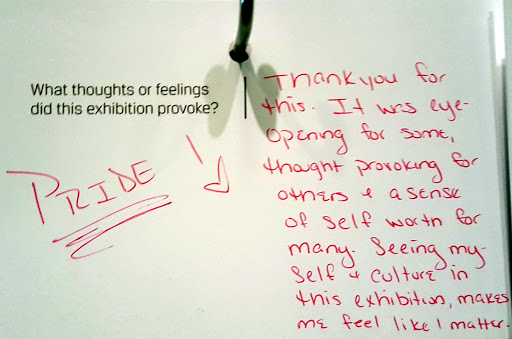
Pride! Thank you for this. It was eye-opening for some, thought provoking for others & a sense of self worth for many. Seeing myself and culture in this exhibition makes me feel like I matter.

It reminded me of how people complain about having an "entire month" dedicated to black history, when in fact every history book is always "white history."

Excitement - we need more of this! We need to feel all of the feels, and put the puzzle pieces together. There is no singular history. There is so much beauty in the world!

My eyes are wide open

The beauty and pain of my culture as a black woman. I've never been more proud.

Being of mixed race, I've always felt as if I was in-between black and white. Never quite belonging to either, never having an identity. This exhibit has shown me the struggle my father's ancestors have faced, and enlightened me to the privilege and class differences my mother's family have known. I know now that I am me because of their history. NOT mulatto, but me; a person that belongs.

I wonder how much more black art has been buried under the weight of America

The hair/wig artwork made me reflect on what my hair style says about me and why I spend so much money obtaining whatever that message is.
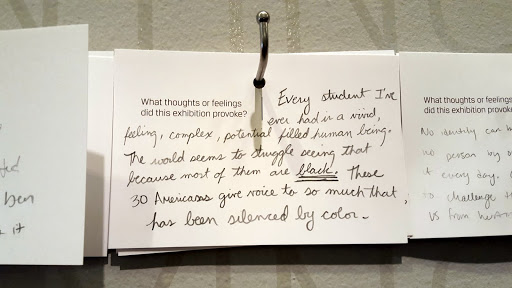
Every student I've ever had is a vivid, feeling, complex, potential filled human being. The world seems to struggle seeing that because most of them are black! These 30 Americans give voice to so much that has been silenced by color.

The circle of KKK hoods around the noose was the most thought-provoking. That is the history of my people. That is how my family continues to think. My white, racist family may not have white hoods, but they have those attitudes. I'm glad to be different from them.

A multitude of cards, all written with eloquence and meaning. THESE words are art, too.
Learn more: http://www.dia.org/calendar/exhibition.aspx?id=4998&iid=
The Detroit Institute of Arts (DIA), one of the premier art museums in the United States, is home to more than 60,000 works that comprise a multicultural survey of human creativity from ancient times through the 21st century. From the first Van Gogh painting to enter a U.S. museum (Self-Portrait, 1887), to Diego Rivera's world-renowned Detroit Industry murals (1932–33), the DIA’s collection is known for its quality, range and depth. The DIA’s mission is to create opportunities for all visitors to find personal meaning in art.
Programs are made possible with support from residents of Wayne, Oakland, and Macomb counties.

Note: We received media passes to the DIA and the 30 Americans exhibit - thank you!
